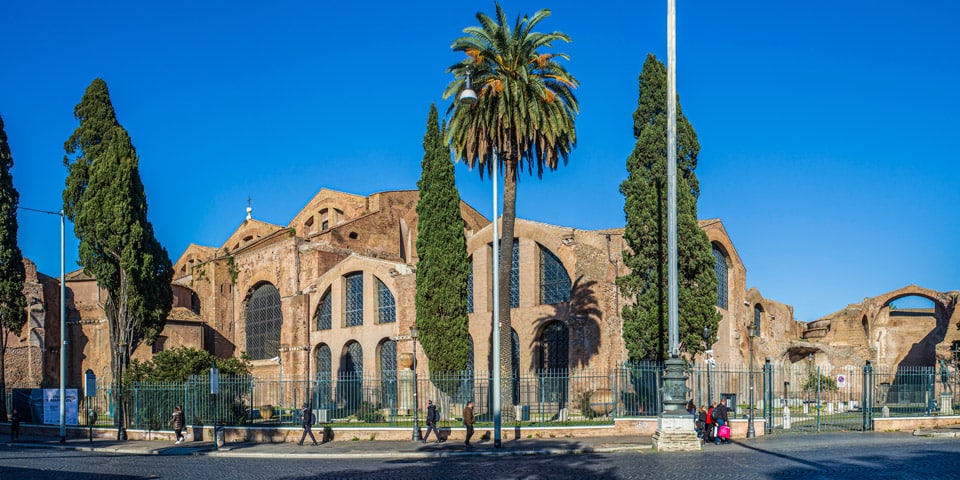

24823 views

| Tickets |
Buy tickets online: |
|---|---|
| Tip | Combined ticket allows entrance to the Baths of Diocletian, Palazzo Massimo and Palazzo Altemps. |
| Opening Hours |
Sunday:
-
Tuesday:
-
Wednesday:
-
Thursday:
-
Friday:
-
Saturday:
-
|
| Recommended tour | |
| Closest bus stops |
|
| Closest subway stations |
|
| Address | Viale Enrico de Nicola, 78, Roma |
| Website | museonazionaleromano.beniculturali.it |
The Baths of Diocletian, known as “Terme di Diocleziano” in Italian, were ancient public baths built in ancient Rome during the reign of the Roman Emperor Diocletian in the 4th century AD.
They were the largest and grandest of the public baths in Rome, capable of accommodating up to 3,000 bathers at once, and served as an essential social and recreational center for the citizens of Rome. Today, the remains of the Baths of Diocletian house the National Roman Museum, showcasing a vast collection of Roman antiquities.
Contents
ToggleIf you’re a lover of the history of Ancient Rome and are looking for an engaging and comfortable way to immerse yourself in its rich past, I highly recommend a tour with a professional guide. This half-day guided tour of the Baths of Diocletian and the National Roman Museum offers just that.
In 3 hours, you’ll explore some of Rome’s lesser-known but equally captivating treasures away from the tourist crowds. You’ll have the chance to walk through the ancient Baths of Diocletian, complete with a courtyard restored by Michelangelo, and visit the Basilica di Santa Maria degli Angeli to marvel at a unique 17th-century planetary sundial. An expert guide will introduce you to rare art pieces like Myron’s Discobolus and the Old Boxer.
The package includes entrance tickets, a professional guided tour, and even hotel pick-up if you’re staying in the city center. Remember that this specialized tour is only available on weekends and must be booked online several weeks in advance.
The Baths of Diocletian, or “Thermae Diocletiani” in Latin, were among ancient Rome’s grandest and most magnificent public bath complexes. The construction of the baths began during the reign of the Roman Emperor Diocletian in the early 3rd century AD and was completed around 306 AD, after his abdication. Diocletian was known for his interest in public works, and these baths were part of his ambitious building projects that aimed to showcase his power and wealth.
The Baths of Diocletian were the most extensive public baths in ancient Rome, covering an immense area of approximately 13 hectares (32 acres). They were designed to accommodate thousands of bathers simultaneously and provide various services and amenities for the citizens of Rome. The vast complex featured multiple bathing rooms, hot and cold water pools, saunas, gymnasiums, and other facilities for relaxation and recreation.
The Baths of Diocletian was a place for bathing and a multifunctional social and cultural center. The complex housed libraries, art galleries, lecture halls, and other spaces where Romans could gather, socialize, and engage in intellectual pursuits. The vast central hall, known as the “frigidarium,” was an awe-inspiring space with massive vaulted ceilings and colossal columns designed to impress and reflect the grandeur of the Roman Empire.
The Baths of Diocletian, an ancient Roman complex, have undergone significant reconstruction and repurposing over the centuries. After their decline following the fall of the Roman Empire, parts of the baths were converted into the Basilica of Santa Maria degli Angeli e dei Martiri in the 16th century, designed by Michelangelo.
This remarkable transformation incorporated the ruins of the ancient baths into the new church, preserving their historical significance while repurposing the site for Christian worship. Today, the Baths of Diocletian are an essential part of the National Roman Museum, providing visitors with a unique opportunity to explore the remains of this once-magnificent complex and witness the ingenious incorporation of ancient Roman ruins into Renaissance architecture.
Today, the Baths of Diocletian are essential to the National Roman Museum in Rome. Visitors can explore the remnants of this once-magnificent complex, witness the grandeur of Roman engineering, and appreciate the historical significance of this ancient public space. The Baths of Diocletian stand as a testament to the remarkable achievements of ancient Rome and continue attracting tourists and history enthusiasts worldwide.
Read also: Ancient Roman Baths of Caracalla.
The National Roman Museum (Museo Nazionale Romano) is renowned in Rome, dedicated to preserving and exhibiting a vast collection of ancient Roman artifacts and archaeological treasures. The museum’s diverse collections are spread across multiple locations, including the Baths of Diocletian, Palazzo Massimo alle Terme, Palazzo Altemps, and Crypta Balbi, showcasing an impressive array of sculptures, frescoes, mosaics, coins, and everyday objects from ancient Rome.
Through its extensive displays, the National Roman Museum offers visitors a captivating journey back in time, providing valuable insights into the rich history and cultural heritage of the ancient Roman civilization.
The Baths of Diocletian are a fascinating historical site with many interesting facts:
Test your knowledge about the Baths of Diocletian by answering the following questions. These questions are aimed at those who have a deep interest in the history of ancient Rome.
Author: Kate Zusmann
This website uses cookies. For more info read the cookies policy
Rome.us © 2025. Created with love by Roman experts and guides.